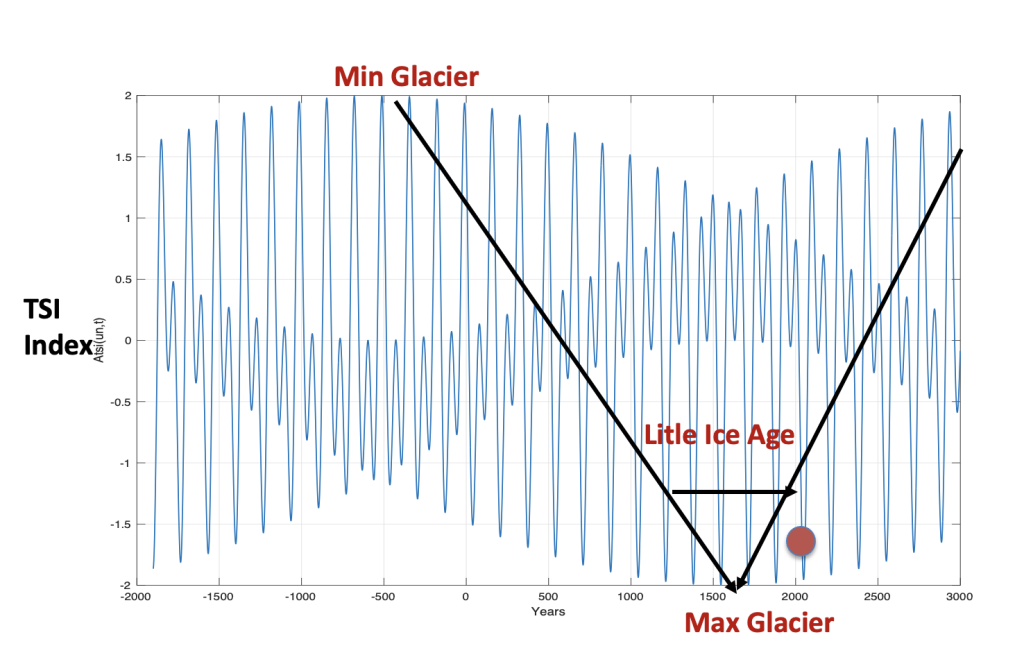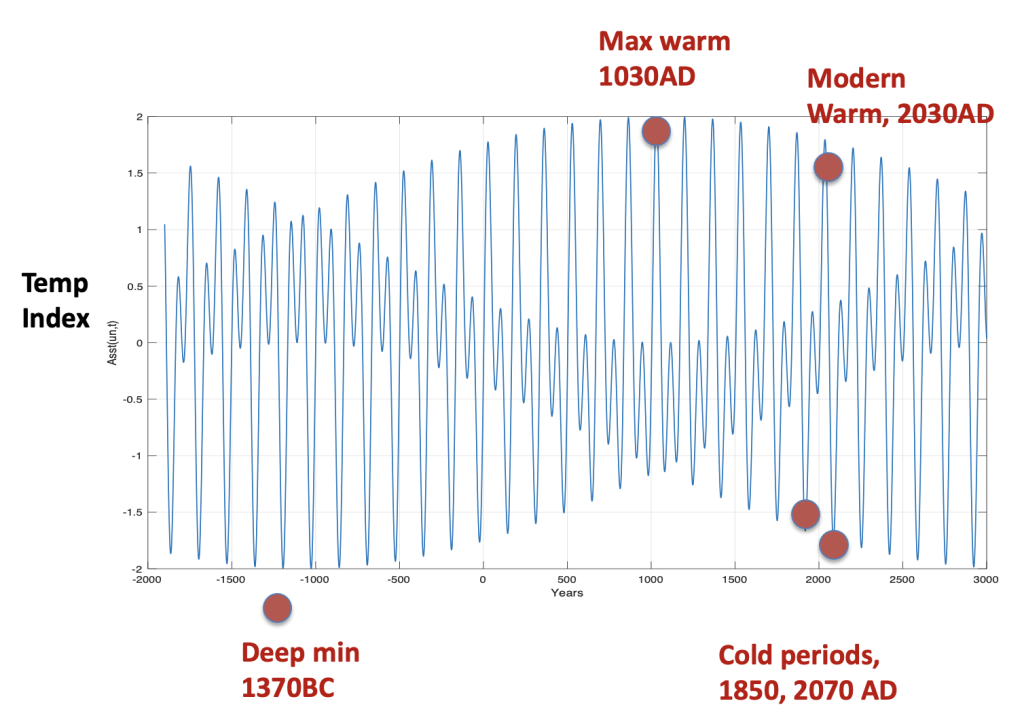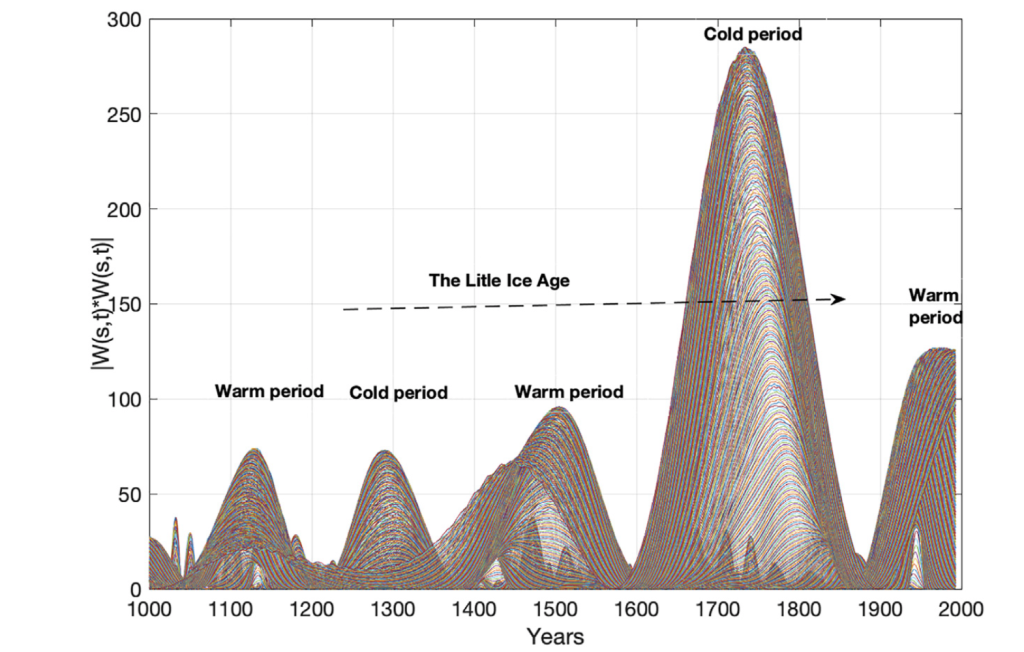Upcoming climate variations have a computed modern temperature maximum at the year 2025 and a computed deep minimum at the year 2070. Interference between solar- forced temperature cycles of 333 years, 2142 years, and 4,450 years and a lunar-forced temperature cycle of 445 years reveals that “The Little Ice Age” covers a total period of 820 years from 1330 to 2150 A.D. and an upcoming temporary cold climate period from 2070 to 2150.
New publication: Frontiers in Astronomy and Space Science [1].
Audio presentation
Yndestad H: Jovian Planet Oscillations, The First Couse of Climate variability (15 min)
The first cause
Climate variations can be traced back to the moon and the Jovian planets (Jupiter, Saturn, Uranus and Neptune), as the first cause.
The explanation
Climate variations are explained by interference. Interference between firs periods modulates a spectrum of new periods. Interference between periods causes amplify maxima and minima when they have the same direction. The periods cancel each other out when periods have different directions.
- Interference between the planets’ elliptical orbits controls the solar position at the solar system Barycenter.
- The sun’s rotation around the Barycenter, influences the solar dynamo and total irradiation from the sun, in periods from 11 to 4450 years.
- Accumulated ocean warming changes the interference pattern and temperature variations in oceans.
- The Earth’s nutation of 18.6 years, controlled by the moon, creates a global 18.6-year standing tidal wave in oceans. Interference between previous tidal waves, creates a spectrum of lunar-forced tidal waves and lunar-forced ocean temperature variations of 18.6 to 446 years.
- Global temperature variations are controlled by interference between a solar forced temperature spectrum and a lunar-driven temperature spectrum in the ocean.
- The Little Ice Age have cold periods when there is constructive negative interference between solar-forced sea temperature periods of 4450 years, 2450 years, 333 years and a lunar-forced sea temperature period of 445 years.

Figure 1. Total Solar Irradiation oscillation from 2000BC to 3000AD controlled by interference between Uranus and Neptune periods.
Figure 1 shows the computed TSI index from 2000BC to 3000AD. In Norway glacier started to grow 500BC, when TSI-index has a maximum. Glacier had a maximum extend at 1745AD when TSI-index has a minimum. The Little Ice Age covers 5 TSI minima and has an upcoming minimum close to 2070AD.

Figure 2. Solar forced accumulation of heat in oceans controlled by interference between Uranus periods and Neptune periods from 2000BC to 3000AD.
Figure 2 shows that accumulation of heat in oceans introduces a new interference pattern of minima and maxima between Uranus forced periods and Neptune forced periods. Global climate has a computed deep minimum I 1370BC, a computed maximum at 1030AD, a computed temporary maximum temperature at the year 2030AD and a computed upcoming temporary minimum at the year 2070AD.

Figure 3 Wavelet power spectrum of Greenland temperature (GISP2) from 1000AD to 1993AD.
Figure 3 shows the wavelet power spectrum of Greenland temperature (GISP2). Minima and maxima are controlled by constructive and destructive interference between a 333-year solar forced sea temperature period and a 446-year lunar forced sea temperature period
Implication of solar-lunar driven climate
Implication of interference between solar forced and lunar forced climate variations are:
- Cold climate periods follow warm climate periods.
- Cold and warm climate periods are never repeat as the same patten
- Cold and warm climate periods are still deterministic, because the Jovian planets and the lunar nodal cycle have deterministic periods.
Upcoming events
The study concludes: “The sea temperature variations from 1890 to 2020 coincide with a solar forced sea temperature minimum in 1896 and a solar forced sea temperature maximum in 2025. In terms of upcoming events, computations suggest the sea surface temperature will have a deep minimum from 2070 to 2150”.
References
- Yndestad H (2022) Jovian Planets and Lunar Nodal Cycles in the Earth’s Climate Variability. Front. Astron. Space Sci. 9:839794. doi: 10.3389/fspas.2022.839794
- Yndestad, H.: Jovian Planets influence on the Earth’s Temperature Variability, EGU General Assembly 2021, online, 19–30 Apr 2021, EGU21-1499, https://doi.org/10.5194/egusphere-egu21-1499, 2021.
- Yndestad, H. (2021). Barents Sea Ice Edge Position Variability 1579-2020. Ålesund, Norway: NTNU-Ålesund. Mai 2010. doi:10.13140/RG.2.2.16122. 41928
- Yndestad, H., and Solheim, J.-E. (2017). The Influence of Solar System Oscillation on the Variability of the Total Solar Irradiance. New Astron. 51, 135–152. doi:10.1016/j.newast.2016.08.020
- Yndestad, H. (2006). The Influence of the Lunar Nodal Cycle on Arctic Climate. ICES J. Mar. Sci. 63 (3), 401–420. doi:10.1016/j.icesjms.2005. 07.015
- Yndestad, H., Turrell, W. R., and Ozhigin, V. (2008). Lunar Nodal Tide Effects on Variability of Sea Level, Temperature, and Salinity in the Faroe-Shetland Channel and the Barents Sea. Deep Sea Res. Oceanographic Res. Pap. 55 (10), 1201–1217. doi:10.1016/j.dsr.2008.06.003
- Lunar forced global warming: https://www.climateclock.no/2021/03/09/lunar-climate/
- The First Cause of climate variability. https://www.climateclock.no/2020/10/18/the-first-cause/
